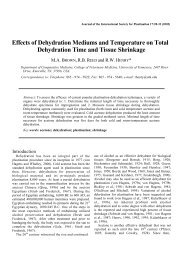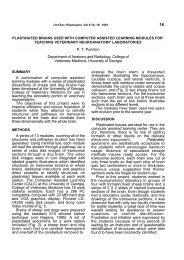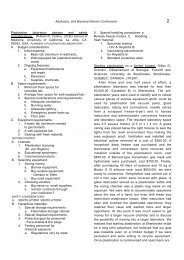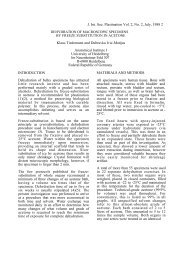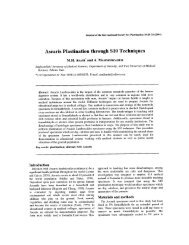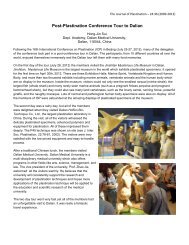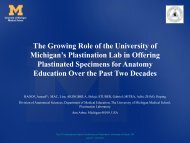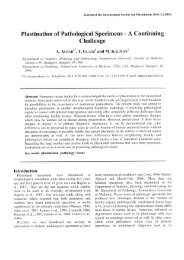Instructions for Authors - Journal of Plastination - International ...
Instructions for Authors - Journal of Plastination - International ...
Instructions for Authors - Journal of Plastination - International ...
Create successful ePaper yourself
Turn your PDF publications into a flip-book with our unique Google optimized e-Paper software.
The <strong>Journal</strong> <strong>of</strong> <strong>Plastination</strong> 25(1): 29 (2013)<strong>Journal</strong> <strong>of</strong> <strong>Plastination</strong><strong>Instructions</strong> <strong>for</strong> <strong>Authors</strong>(Revised January 2013)JOURNAL OF PLASTINATION is owned and controlledby the <strong>International</strong> Society <strong>for</strong> <strong>Plastination</strong> (ISP).Goals - The <strong>Journal</strong> <strong>of</strong> <strong>Plastination</strong> (ISSN 1090-2171) is to provide a medium <strong>for</strong> the publication <strong>of</strong> scientificpapers dealing with all aspects <strong>of</strong> plastination andpreservation <strong>of</strong> biological specimens.Submission GuidelinesAll manuscripts must be submitted to the Editorial Office viathe e-mail: carlos.baptista@utoledo.edu. If you experienceany problems or need further in<strong>for</strong>mation, please contacteither Dr. Carlos Baptista, carlos.baptista@utoledo.edu, orDr Selcuk Tunali, tunali@hacettepe.edu.tr.<strong>Authors</strong> must have an e-mail address at which they may bereached.Necessary Files <strong>for</strong> Submission Include:• Cover letter• Manuscript (including references and figurelegends)• Table(s) (when appropriate)• Figure(s) (when appropriate)• Copyright Release Form (after acceptance)Note: The above items should be prepared as separate files.Each file must contain a file extension (.doc, tif, jpg, eps).• File <strong>for</strong>mats appropriate <strong>for</strong> text and tablesubmissions: Micros<strong>of</strong>t Word• File <strong>for</strong>mats appropriate <strong>for</strong> figure submissions:TIFF, JPEG (JPG) and EPSCategories <strong>of</strong> submissions:Articles published in <strong>Journal</strong> <strong>of</strong> <strong>Plastination</strong> are grouped intogeneral article types (listed below). Final designation <strong>of</strong> amanuscript’s article type is determined by the EDITOR.• Original Research – <strong>Plastination</strong>• Original Research – preservation• Education• Case reports• Technical brief notes• Review - by invitation only• Legacy – institutions and people• Correspondence• EditorialAcceptance <strong>of</strong> a submission implies the transfer <strong>of</strong>copyright from the authors to the publisher. It is the author'sresponsibility to obtain permission to reproduce illustrations,tables and figures from other publications.Copyright Transfer Form may be downloaded fromhttp://www.journal.plastination.org/downloads/copyright.pdf.After the <strong>for</strong>m is completed and signed by all the authors, itshould be submitted to the Editorial Office(carlos.baptista@utoledo.edu) as a pdf or jpeg file via an e-mail attachment.Manuscript preparationCover LetterThe cover letter should include a statement <strong>of</strong> authorship,notification <strong>of</strong> conflicts <strong>of</strong> interest, ethical adherence, andany financial disclosures.Cover letters may be addressed to the Editor-in-Chief,<strong>Journal</strong> <strong>of</strong> <strong>Plastination</strong>.ManuscriptThe manuscript should consist <strong>of</strong> subdivisions in thefollowing sequence:Title PageAbstract with keywordsTextIntroductionMaterials and methodsResultsDiscussionReferencesFigure LegendsTitle PageThe first page <strong>of</strong> the manuscript should include:• Title <strong>of</strong> paper• Each author’s name• Institution from which paper emanated, with city,state, and postal code. Each affiliation should be listed as aseparate entity, with a superscript number that links it to theindividual author.For example:S. D. HOLLADAY 1 *, B. L. BLAYLOCK 2 and B. J. SMITH 11 Department <strong>of</strong> Biomedical Sciences and Pathobiology,Virginia Maryland Regional College <strong>of</strong> VeterinaryMedicine, Virginia Polytechnic Institute and StateUniversity, Blacksburg, VA 24061-0442, USA.2 College <strong>of</strong> Pharmacy and Health Sciences, University <strong>of</strong>Louisiana at Monroe, Monroe, LA 71209, USA.• Corresponding Author’s name, address, telephoneand telefax numbers, and e-mail address.
The <strong>Journal</strong> <strong>of</strong> <strong>Plastination</strong> 25(1):30For example:*Correspondence to: Dr Shane D. HOLLADAY, Department<strong>of</strong> Biomedical Sciences and Pathobiology, VirginiaMaryland Regional College <strong>of</strong> Veterinary Medicine,Virginia Polytechnic Institute and State University,Blacksburg, VA 24061-0442, USA. Tel.: +001 404 7396403; Fax.: +001 404 739 6492; E-mail:journal93@plastina.orgIt is the corresponding author’s responsibility to notify theEditorial Office <strong>of</strong> changes <strong>of</strong> address. Only thecorresponding author should communicate with theEditorial <strong>of</strong>fice <strong>for</strong> matters regarding each manuscript.Abstract & Key Words:The abstract should be no longer than 250 words. It shouldcontain a description <strong>of</strong> the objectives, materials andmethods, results, and conclusions. The abstract shouldinclude a section on technique/technical development if thepaper is significantly technical in nature. The abstract mustbe written in complete sentences and be intelligible withoutreference to the rest <strong>of</strong> the paper. No references should beused in the abstract.On the same page, list, in alphabetical order, five KeyWords that reflect the content <strong>of</strong> the manuscript. Consult theMedical Subject Headings <strong>for</strong> appropriate key words. Keywords should be set in lower case (except <strong>for</strong> essentialcapitals), separated by a semicolon and bolded.References:• References to published works, abstracts and booksmust include all that are relevant and necessary to themanuscript.• Citations in the text should be in parentheses andlisted chronologically; e.g. (Bickley et al., 1981; vonHagens, 1985; Henry and Haynes, 1989) except when theauthors name is part <strong>of</strong> a sentence; e.g. "…von Hagens(1985) reported that…" When references are made to morethan one paper by the same author published in the sameyear, designate each citation as 1999 a, b, c, etc.• Literature cited may only include the publications,which are cited in the text. References are to be listedalphabetically using abbreviated journal names according toIndex Medicus. Page numbers <strong>of</strong> the citation must beincluded.• Examples <strong>of</strong> the reference style are as follows:• For a journal article:Bickley HC, von Hagens G, Townsend FM. 1981: Animproved method <strong>for</strong> preserving <strong>of</strong> teaching specimens.Arch Pathol Lab Med 105:674-676.• For a book section:Henry R, Haynes C. 1989: The urinary system. In: HenryR, editor. An atlas and guide to the dissection <strong>of</strong> the pony,4 th ed. Edina, MN: Alpha Editions, p 8-17.• For other publications:Von Hagens G. 1985: Heidelberg plastination folder:Collection <strong>of</strong> technical leaflets <strong>for</strong> plastination. Heidelberg:Anatomiches Institut 1, Universität Heidelberg, p 16-33.Figure legends• Legends <strong>for</strong> all figures should be brief, specific andnot be a substitute listing <strong>for</strong> the result section, and appearon a separate page at the end <strong>of</strong> the manuscript, followingthe list <strong>of</strong> references.• Legends must be numbered consecutively as theyfirst appear in the text.• All symbols or abbreviations appearing in anyfigure must be defined in the legend.Tables• All tables must be cited in the text and have titles.Table titles should be complete but brief. In<strong>for</strong>mation otherthan that defining the data should be presented as footnotes.• Create tables using the table creating and editingfeature <strong>of</strong> Micros<strong>of</strong>t Word. Do not use Excel or comparablespreadsheet programs.• Each table should be simple and uncomplicated,with NO vertical and as few horizontal lines as possible.• Each table is to appear on a separate page and mustinclude the table title and appropriate column heads.• Save each table in a separate word document fileand upload individually, like figures.• Do not embed tables within the body <strong>of</strong> themanuscript.Figures• All figures must be cited in the text and must havelegends.• Each figure should be attached as a separate fileand labeled with the appropriate number.• Figures should be created, saved and submitted aseither a TIFF, JPEG (JPG) or an EPS file.• Line drawings must have a resolution <strong>of</strong> at least1200 dpi, and electronic photographs, scanned images,radiographs, CT and MRI scans must have a resolution <strong>of</strong> atleast 300 dpi.• The size <strong>of</strong> each figure should be at least 8.25 cm /3.25 inches (one-column width) or 16 cm / 6 inches (twocolumnwidth).• Magnification must be recorded and have a “scalebar” in the photo. Since reproduction <strong>of</strong> illustrations iscostly, authors should limit the number <strong>of</strong> figures to thosewhich adequately present the findings, and add to theunderstanding <strong>of</strong> the manuscript.• Figures that are submitted in color must bepublished in color. <strong>Authors</strong> are responsible <strong>for</strong> the costs <strong>of</strong>any color reproductions. Contact the editor <strong>for</strong> details.



